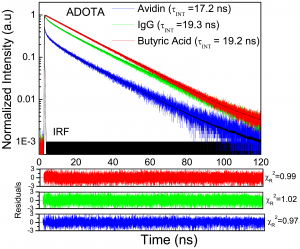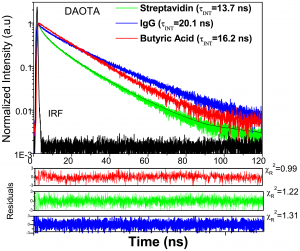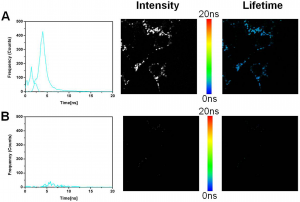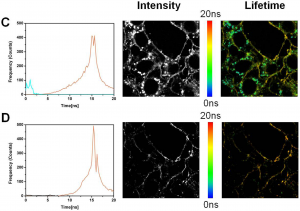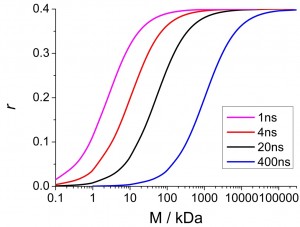Long lifetime dyes
The long fluorescence lifetime dyes: KU530 (ADOTA) and KU560 (DAOTA), are bright fluorescent dyes with emission in the red. Their unique properties can be used in imaging and assay. A key property can be illustrated by the fluorescence intensity decay profiles, where other dyes and the autofluorescence have decayed within the 40 ns, KU530 and KU560 emit light for at least twice the time period. This is true for the free dyes and bioconjugates are very similar. For KU560 the performance is enhanced upon conjugation. KU530 and KU560 are available with pendant free acids, active esters, malimides, bio-orthogonal functional groups, and as kits for bioconjugation.
- Fluorescence intensity decay profiles for free ADOTA and in Avidin / IgG conjugates
- Fluorescence intensity decay profiles for free DAOTA and in Streptavidin / IgG conjugates
KU530 and KU560 have high quantum yields and thus, despite a very long fluorescence lifetime, a good brightness. In combination with advanced optical microscopes this results in images of unsurpassed contrast. The long fluorescence lifetime can be used as a signature in fluorescence lifetime imaging microscopy (FLIM), and for time-gated imaging, the can be done on a nanosecond time-scale allowing for high cycle times and thus short imaging times.
- FLIM image of 4T1 endothelial cell
- FLIM image of 4T1 endothelial cell stained with ADOTA-C18
In polarisation based assays the fluorescence lifetime determines the size of the systems that can be screened. Thus high-throughput screening has due to the lack of long fluorescence lifetime dyes been limited to probe small drugs binding to large accepters. KU530 and KU560 are long fluorescence lifetime dyes and now large polypeptide drugs can be screened using polarisation based HTS.

